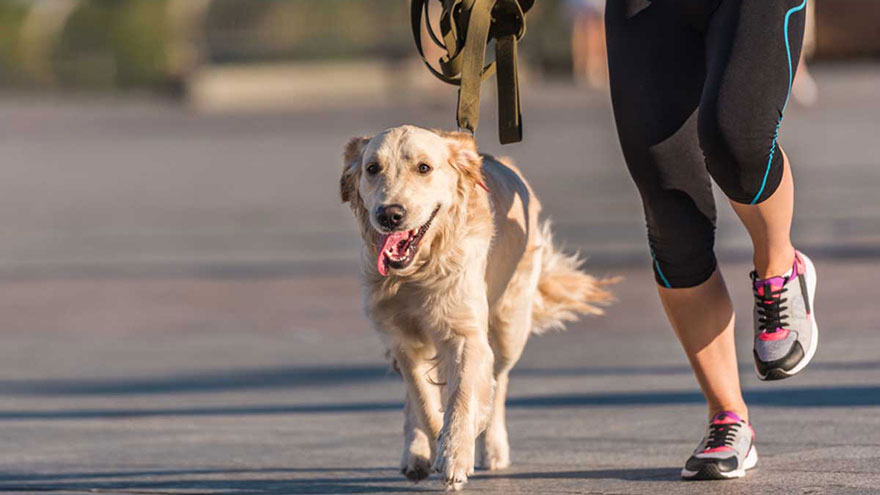The Best Dog Breeds to Run With
Having a dog for a running partner offers you companionship and a bit of protection and it’s good for your pup. The best dog breed to run with depends on the type of running you do.
Some dogs, such as German shorthaired pointers, are more suitable for a long run, while others, such as beagles, are better for short distances.

Long or Far; Fast or Slow
If your running is limited to less than 10 kilometers, Runner’s World notes that a dog with a lean, muscular build and an interest in sprinting is more suitable for shorter distances. The greyhound, English setter, golden retriever, Labrador retriever, beagle and pit bull are suited for a brisk, brief run. For distances greater than 10 kilometers, a dog with well-muscled hind legs and a medium build is ideal.
Consider the Jack Russell terrier, Weimaraner, goldendoodle, vizsla or German shorthaired pointer. When you’re running for speed, taking a mile in seven minutes or less, you’ll want a dog who’s lean and ready to race. The vizsla, greyhound, whippet, Weimaraner and German shorthaired pointer will be able to keep the pace. A bigger dog, such as the dalmatian, standard poodle, Labrador retriever and catahoula is usually able to stick out a long run at a slower pace.
On the Trails
Trail running offers different challenges, for you and your running partner. If you’re going off the beaten path, you’ll want a sure-footed dog who can keep up and responds to you. Herding and hunting dogs are known for their agility and responsiveness to commands, given proper training. The border collie, Belgian sheepdog, Australian cattle dog, Weimaraner, vizsla and German shorthaired pointer are usually up to the task of navigating trails.
When the path is more well-traveled, such as in a local park, a dog who mixes well with other people and dogs is a good choice. Consider a golden or Labrador retriever, a standard poodle or Labradoodle as a path partner.
Weather Conditions
Consider your climate when you choose your canine running partner. Fur thickness, not length, determines how well-suited a dog is to exercising outside. Double-coated breeds, such as Labradors, huskies and Akitas can withstand colder temperatures than a short, thin coat, such as the greyhound has.
If you live in a cold climate and your running partner has a short coat, take care to provide him with a dog sweater or coat to cover his torso. Your dog’s track suit shouldn’t have seams or material under his arms that will chafe him.
Breeds suitable for warm weather running include the Rhodesian ridgeback, fox terrier, Airedale terrier and vizsla. The malamute, Siberian husky and German shepherd are better equipped for cold weather outings.
Brachycephalic breed dogs, such as the bulldog, pug and bullmastiff are not good candidates for running partners. Short-nosed dogs have abnormalities in their throats and noses that make breathing difficult, particularly in warm weather.
Ready to Run
A dog doesn’t have to be purebred to be born to run. A high energy level and nimble feet help, as does a lean build. However, as long as your dog is eager for exercise, he’ll probably make a fine running partner, as long as you introduce him to the exercise carefully.
If running is new to your dog, you should have the vet give him a checkup to make sure he’s good to go. Young and old dogs aren’t suited for distance running, so consider your dog’s age when you ask him to keep you company for a run.
Give your dog time to work up to your routine; he’ll need opportunity to build his stamina to complete a long or hard run. Your dog should be trained to stay by your side when you run — a sudden move in front or away from you can be hazardous for both of you.
Watch your dog for signs he’s struggling; excessive panting or trouble breathing are signs you’re pushing him too much and that he needs to stop. He should have time to recover from his exercise before taking another run. When you’re finished the day’s workout, examine your dog’s feet for any trauma, such as cuts and scrapes. Check him for ticks, burrs or other bits that may become entangled in his fur.
Carry water on your run to keep yourself and your dog sufficiently hydrated. Make sure your dog has plenty of water to drink after his exercise.
You Might Also Like :: The Best Dog Breeds for Walking

